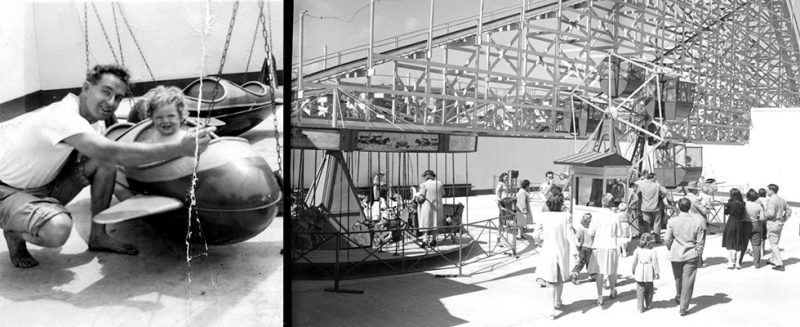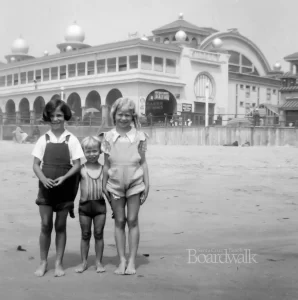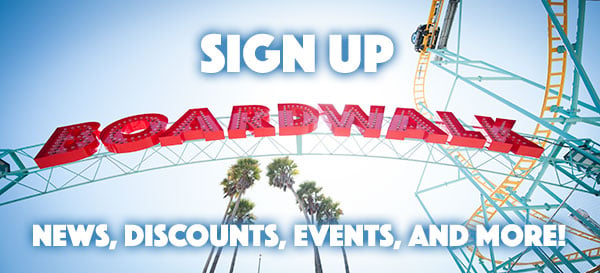
From its earliest years, the Boardwalk has been a mecca for youth. A 1914 photo from our local Museum of Art & History shows a cluster of activities on the beach for youngsters – several swing sets, two tall slides, a teeter-totter, balance beam, and several contraptions I don’t quite know how to describe. Another Boardwalk archive photo from around that same time reveals a long line of finely dressed youngsters on the sand waiting their turn on a distant slide.
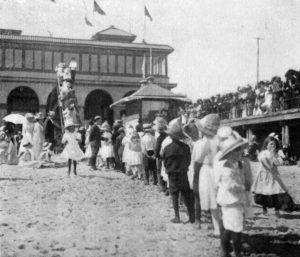
A recently discovered map, dated to around 1925, conveys management’s interest in establishing a children’s playground on the Boardwalk, located alongside the Giant Dipper. A year later, Joyland, an elaborate fenced children’s play zone opened for the summer season. The Santa Cruz Evening News of April 26, 1926, stated, “Parents will now be able to ‘check’ their children at the playground and spend the day at the beach, knowing that their kiddies will be well taken care of by expert nurses.” The article further stated the area had a “pint-sized” Ferris wheel, merry-go-round, and several teeter-totters.
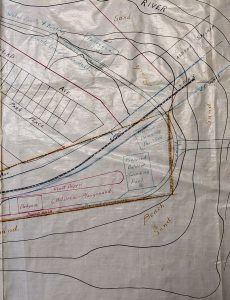
1926 also seems to be the year the Boardwalk began hosting Easter egg hunts, a festivity that hundreds of youngsters annually enjoyed over the next 60 years.
A retail concession dubbed Toyland opened in 1927, adjacent to Joyland. Hundreds of children’s toys and novelties, all of “good quality and class,” filled the stand’s shelves and displays.

In the summer of 1928, kiddie games and races were featured every Wednesday afternoon on the beach opposite Joyland. In August that year, the youngsters were also treated to contests on the beach bandstand. Pie, watermelon, and cracker-eating challenges abounded. First-place winners received a free pass to the Plunge. Years later, “Lolly-Pop” Day was declared on Wednesday evenings for kids under 12. The lickin’-good treats were passed out along the Boardwalk as an enticement to ride and play. The fastest lolly-pop eater received a special award in a bandstand contest.

Our records reveal little regarding Joyland or any cluster of kiddie activities in the 1930s. However, in the early 1940s, we know families enjoyed a designated Kiddie Land in the area alongside the Giant Dipper. Seaside Company President Louis Jenkins extolled the success of these child-oriented experiences in prepared remarks for the 1948 annual amusement industry convention. He stated that during the war years, business in these kiddie areas faired reasonably well. Since higher prevailing wages for working moms and dads chased fewer commercial goods during the early 1940 war years, families frequented parks like the Boardwalk with their energy-laden youngsters. By 1945, Boardwalk records show that a 21-horse kiddie merry-go-round, whip ride, an airplane ride with 6-winged gliders, and a 25-foot high, 6-car Ferris wheel operated in our Kiddie Land.
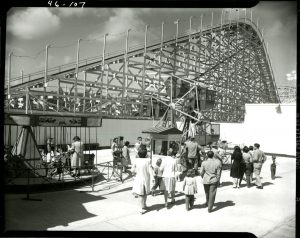
In that same speech, Jenkins cited the progressive financial success of our Boardwalk’s kiddie area during the previous five years. He reported the Boardwalk recently added a new kiddie auto ride and replaced the kiddie airplane ride, which was the first ride improvement since pre-war days. Jenkins was quite optimistic about the popularity of the Kiddie Land experience in upcoming years.
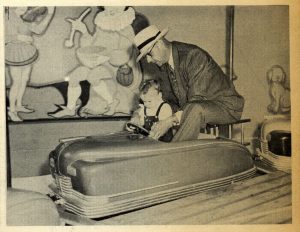
By 1950, no doubt a product of Jenkins’ enthusiasm, the Boardwalk’s kiddie land boasted a snack concession with a counter servicing directly into the area. I knew that concession as Bright Spot #2. A Mother Goose-themed ticket booth appeared at some point during those years. A kiddie circus ride and a midget auto ride had been added, and a gasoline-powered, streamlined miniature train traversed a 665-ft, 12-inch gauged track. Sleekly painted in the red, orange, and black colors of the Southern Pacific’s Daylight passenger train, the 4-car consist traversed a 32-foot tunnel that also acted as its storage shed.
Current Seaside Company Board Chairman, Charles Canfield, remembers overseeing Bulgy, the fish ride back in the mid-1950s, when he was a teenage ride operator earning $1.15 per hour.
A July 1954 letter from Boardwalk promotions guru Skip Littlefield to Southern Pacific railroad hints of the Seaside Company’s interest in further expanding Kiddie Land’s footprint. In the letter, Littlefield describes management’s contemplation for filling the empty, sandy area at the eastern end of the park and elevating the space to Boardwalk height. Since communities had been staging retired steam locomotives in many city parks during that time, he requested the railroad consider donating an engine for display in this enlarged Kiddie Land and public park area.
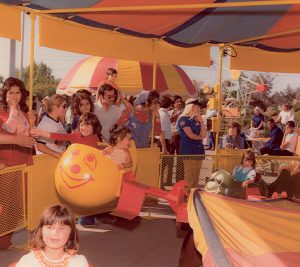
A fortunate change of plans for that space culminated in the construction of a cement seawall, basement, and ride-supporting deck during the winter of 1960 – 1961 throughout most of the Boardwalk’s eastern end. In addition to making space for more adult and family-oriented rides, the project provided a plot for an enlarged Kiddie Land between the re-located, tower-roofed Bright Spot #2 concession and the Boardwalk’s eastern boundary.
In a conversation with me, former Boardwalk concessionaire Marshall Miller recalled his time as a Kiddie Land ride operator in the early 1960s. He remembered there were two supervisors and four-or-so attendants on busy days. Each operator ran one of the rides – a merry-go-round, boats, Bulgy, cars, Ferris wheel, and the miniature train. When things were slower, each might operate several rides. Senior supervisors usually clutched the train ride, relishing the comfort of sitting while working. Dingers counted the number of riders, and electric timers measured their enjoyment.
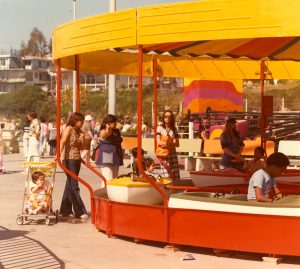
Miller remembered there were no fences around the rides. Parents usually set their kids into the conveyance themselves. Before starting the ride, the operator would check that each child was safely secured. However, if a kid got scared during the ride’s motion, the worried parent often tried to extract the youngster while it was still moving. With assistance from the alert operator, this generally worked out OK, he said. But the boats were a different story. If an anxious parent grabbed a boat by the stern to stop it, a surge of water would undoubtedly spill over the side and swamp the rear seat. Any young tot aboard became sopping wet.
While I never operated a kiddie ride, I did ride them, more years ago than I care to acknowledge. I vaguely remember enjoying the ups and downs and rounds and rounds of Bulgy and the boat ride. I also recall playing around with them in the early 1950s when the Boardwalk was closed. Sometimes a brother and I accompanied our dad as he serviced and repaired the nearby concession. We’d while away time by climbing in and around the closed rides, moving any one by hand that wasn’t chained in place. We could jump in and rock each other in the Ferris wheel cages. We could also lock one or the other into the cage if either of us was not alert enough to keep that from happening.
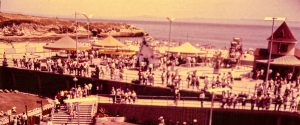
By the late 1960s, the Seaside Company wanted to add more rides in the western sector of the Boardwalk, expecting they would operate more year-round. A two-level building was planned to make this happen. The second level of the new structure was intended to be the new home for Kiddie Land. A new set of bumper cars and two new eateries comprised the Boardwalk-level space.
Sadly, the decades-worn Fun House that many still remember as a “babysitting paradise” had to go. In the winter of 1971-1972, we demolished that building to make way for the new one.
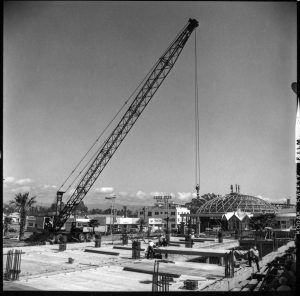
After construction of the two-story structure got underway, company leaders found a compact steel roller coaster that would fit on the upper deck. Since this would be a popular and profitable ride addition, construction stopped long enough for plans to be altered to accommodate the coaster’s weight. The Jet Star Coaster debuted in 1972. Kiddie Land remained relegated to the eastern end of the Boardwalk.
In the 1970s, proportionately fewer small children accompanied their families to the Boardwalk than during the baby-boom of the 1950s. Charles Canfield remembers that Kiddie Land would close earlier than the rest of the Boardwalk because parents needed to take their young tikes home sooner than the park closed. Eventually, adult rides were incorporated into the Kiddie Land space. Rides for the tiny tots were squeezed amid their bigger cousins wherever possible, as is the case today. Although each ride is fenced off for safety’s sake, today’s parents can stand close enough to enjoy their child’s experience and coax them towards a perfect memory-making photo. In some cases, chaperones can actually accompany their youngster on the kiddie ride.
While our kiddie land area is no longer with us, rides like Bulgy the Whale and the little Speed Boats still harken back to the 1950s, when today’s grandparents rode those same rides. In my mind’s eye, it does not seem that long ago!
Do you have any kiddie ride stories to share – or photos of those times? Let me know.
’till next time
Ted
archives@beachboardwalk.com


